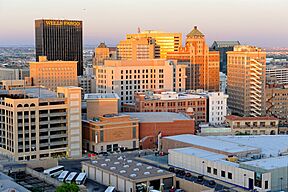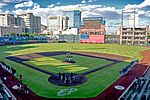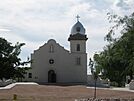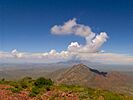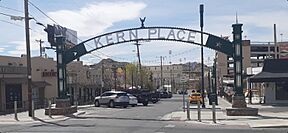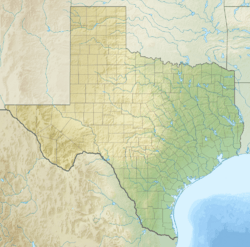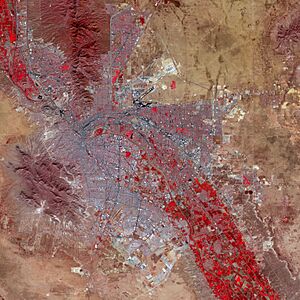El Paso, Texas facts for kids
Quick facts for kids
El Paso, Texas
|
|||
|---|---|---|---|
|
Downtown El Paso
Southwest University Park
Kern Place
|
|||
|
|||
| Nicknames:
The Sun City, El Chuco
|
|||
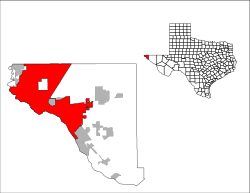
Location in El Paso County and the State of Texas
|
|||
| Country | United States | ||
| State | Texas | ||
| County | El Paso | ||
| First settlement | 1680 | ||
| Settled as Franklin | 1849 | ||
| Renamed El Paso | 1852 | ||
| Town laid out | 1859 | ||
| Incorporated | 1873 | ||
| Government | |||
| • Type | Council–manager | ||
| Area | |||
| • City | 259.25 sq mi (671.46 km2) | ||
| • Land | 258.43 sq mi (669.33 km2) | ||
| • Water | 0.82 sq mi (2.13 km2) | ||
| Elevation | 3,888 ft (1,185 m) | ||
| Population
(2020)
|
|||
| • City | 678,815 | ||
| • Rank | 66th in North America 22nd in the United States 6th in Texas |
||
| • Density | 2,626.69/sq mi (1,014.17/km2) | ||
| • Urban | 854,584 (US: 53rd) | ||
| • Urban density | 3,339.7/sq mi (1,289.5/km2) | ||
| • Metro | 868,859 (US: 67th) | ||
| Demonym(s) | El Pasoan | ||
| GDP | |||
| • Metro | .283 billion (2022) | ||
| Time zone | UTC−07:00 (MST) | ||
| • Summer (DST) | UTC−06:00 (MDT) | ||
| ZIP Codes |
|
||
| Area codes | 915 | ||
| FIPS code | 48-24000 | ||
| GNIS feature ID | 2410414 | ||
El Paso is a big city in Texas, located right on the border with Mexico. Its name means "the pass" in Spanish, because it's a natural crossing point through mountains. In 2020, about 678,815 people lived here, making it one of the largest cities in the United States and the sixth largest in Texas.
El Paso sits on the Rio Grande river, directly across from Ciudad Juárez, a very large city in Mexico. Together, these two cities and nearby Las Cruces, New Mexico, form a huge international area. This area is sometimes called the Borderplex and has about 2.7 million people. It's known for having a large workforce that speaks both English and Spanish.
The city is home to important places like the University of Texas at El Paso (UTEP) and a major medical center. El Paso also has a strong connection to the U.S. military, with Fort Bliss and other important federal offices located here. It hosts the annual Sun Bowl college football game, which is one of the oldest in the country. El Paso has won the "All-America City Award" five times and has often been ranked as one of the safest large cities in the U.S. A large part of its population, about 81%, is of Hispanic background.
Contents
History of El Paso
El Paso has a very long and interesting history. People have lived in this area for thousands of years! Ancient tools found at Hueco Tanks show that hunter-gatherers were here as far back as 10,000 to 12,000 years ago. Later, early farmers settled here.
Early Days and Spanish Explorers
When Spanish explorers first arrived, they met tribes like the Manso, Suma, and Jumano. These groups later mixed with people from central Mexico. In 1581, the Chamuscado and Rodríguez Expedition explored the area. Then, in 1598, Spanish explorer Don Juan de Oñate rested near the Rio Grande. He even held a special Thanksgiving Mass there.
The city of El Paso del Norte (which is now Ciudad Juárez in Mexico) was founded in 1659. In 1680, a small village in the El Paso area became a temporary capital for the Spanish territory of New Mexico. This happened after a Native American uprising called the Pueblo Revolt.
Becoming Part of Texas
The Texas Revolution in 1836 didn't affect El Paso much at first. However, Texas claimed this region. For a while, both Mexican and Texan governments tried to control the area. By 1846, Texas took full control. After the Mexican–American War ended in 1848, the Treaty of Guadalupe Hidalgo officially made the settlements on the north side of the Rio Grande part of the United States.
El Paso County was created in 1850. A military post was set up in 1849, which helped the town of Franklin grow. This town later became El Paso, Texas. In 1859, a company bought the land and hired Anson Mills to plan the streets of downtown El Paso.
During the American Civil War, Confederate forces were in El Paso until Union soldiers took over in 1862. After the war, more people moved to El Paso. The city was officially formed in 1873. When railroads arrived in 1881, the population grew very quickly. El Paso became a busy, fast-growing town.
The 1900s to Today
In 1909, U.S. President William Howard Taft and Mexican President Porfirio Díaz met in El Paso and Ciudad Juárez. This was the first time presidents from both countries met. Many security forces were there to keep everyone safe.
The Mexican Revolution (1910-1920) greatly impacted El Paso. Many people from Mexico came to the city seeking safety. This brought new businesses and culture. However, there were also conflicts and violence during this time.
By 1920, El Paso's population was over 100,000. The 1920s and 1930s saw businesses grow, partly due to the Prohibition era. However, the Great Depression hit the city hard, and the population decreased until after World War II.
After the war, the military presence grew, and oil was discovered nearby. This helped El Paso's economy boom. Industries like copper smelting and oil refining became important. Also, a program called the bracero program brought workers from Mexico to the area. By 1965, Hispanic people became the majority in El Paso again. The city continued to grow, thanks to its strong ties with Mexico.
In the 1970s, the Farah strike happened in El Paso. Mexican-American women led this strike against a clothing company, asking for better pay and working conditions.
Geography and Location
El Paso is in a unique spot where three states (Chihuahua in Mexico, New Mexico, and Texas) and two countries (Mexico and the U.S.) meet. It's the only major city in Texas that is in the Mountain Time Zone.
El Paso is actually closer to the capital cities of four other states than it is to Austin, the capital of Texas! For example, Santa Fe, New Mexico, is only about 273 miles away, while Austin is 528 miles away.
The city is located in the Chihuahuan Desert, which is a large desert region. The Franklin Mountains stretch into El Paso from the north. They almost divide the city in half. The city's elevation is about 3,740 feet above sea level. North Franklin Mountain is the highest point in the city, reaching 7,192 feet. You can see this peak from far away!
The Franklin Mountains State Park is huge, covering 24,000 acres, and is one of the largest urban parks in the United States. It's entirely within El Paso. The Rio Grande river flows through the area, forming the border with Mexico.
On November 8, 2023, a 5.3 magnitude Earthquake happened near El Paso.
Cityscape and Buildings
El Paso has many interesting buildings. The WestStar Tower is the tallest, reaching 314 feet. The Wells Fargo Plaza is another tall building, known for its lights that used to show designs like the U.S. flag or a Christmas tree.
El Paso's Neighborhoods
El Paso is made up of several different neighborhoods, each with its own feel.
Downtown and Central El Paso
This area is the heart of the city and has some of El Paso's oldest and most historic neighborhoods. It's home to about 45,000 people. Downtown is where the city's economy thrives. It's also close to the airport, the border, and Fort Bliss.
Northwest El Paso
Also called West El Paso, this area includes the "Upper Valley," which is the greenest part of the county because of the Rio Grande. It has some of the city's wealthiest neighborhoods and is growing quickly.
West-Central El Paso
This part of town is home to The University of Texas at El Paso (UTEP). The Kern Place and Sunset Heights historic districts are here. Kern Place is very popular with college students, with many restaurants and coffee shops. Sunset Heights is one of the oldest areas, where many wealthy families built their homes. Even the famous revolutionary, Francisco "Pancho" Villa, lived here for a time.
Northeast El Paso
This area is east of the Franklin Mountains. It grew a lot in the 1950s and 60s. It's a diverse area, partly because many military families live here. New developments are planned, including a large community with homes, parks, and a lazy river!
East El Paso
This is the largest and fastest-growing part of El Paso, with over 200,000 people. It includes one of the most populated ZIP codes in the country.
Mission Valley
This area is considered the oldest part of El Paso. It dates back to the late 16th century when Texas was part of New Spain. Three old Spanish missions, built in the 1600s and 1700s, are still standing here and are used as churches today. These include the Ysleta Mission. The Tigua tribe, one of Texas's recognized Native American tribes, also lives in this valley.
Nearby Towns and Suburbs
El Paso is surrounded by many smaller towns in Texas and New Mexico. Some of the biggest Texas suburbs are Socorro, Horizon City, and San Elizario. Towns like Anthony, Santa Teresa, and Sunland Park in New Mexico are also very close.
El Paso's Climate
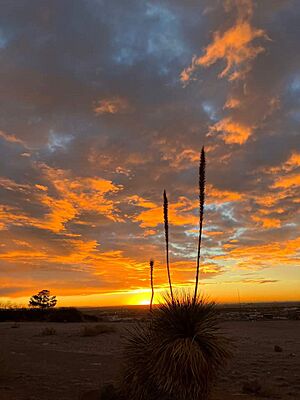
El Paso has a hot desert climate. This means it has hot summers with low humidity and cool, dry winters. It rains about 8.8 inches per year, mostly from June to September. This rain comes from the North American Monsoon, which brings moisture from the Pacific Ocean and Gulf of Mexico.
El Paso is known as "The Sun City" because the sun shines about 302 days a year! Because it's dry and windy, El Paso sometimes has sand and dust storms, especially in the spring.
It can snow in El Paso, especially in the higher parts of the city and mountains. Sometimes, there have been big snowstorms, like in 1987 when over 22 inches of snow fell! However, many years see no snow at all.
Temperatures can vary a lot. The average temperature in December is about 46°F, and in July, it's about 84°F. It can get very hot, with highs over 100°F about 28 days a year. The hottest temperature ever recorded was 114°F in 1994. The coldest was -8°F in 1962.
Flooding in El Paso

Even though El Paso doesn't get much rain, heavy summer thunderstorms can sometimes cause flooding. In 2006, a lot of rain fell in a short time, causing major flooding across the city. This happened partly because some areas were built in natural water paths called arroyos.
People and Culture
El Paso's culture is a special mix of American and Mexican traditions. This is because of its location on the border and its large Hispanic population.
Annual Events and Festivals
El Paso hosts many fun events throughout the year:
- Amigo Airsho: One of the top air shows in the country, with amazing planes and stunts.
- KLAQ Great River Raft Race: People build unique rafts and float down the Rio Grande.
- Southwestern International PRCA Rodeo: A celebration of western culture and one of the oldest rodeos in the nation.
- La Fiesta de las Flores: A three-day festival celebrating El Paso's Hispanic heritage with music, food, and parades.
- El Paso Balloonfest: Hot air balloons fill the sky, with concerts and fun at a water park.
- El Paso Sun City Pride: The largest annual LGBT event in the region, attracting thousands.
Music and Comedy Festivals
- El Paso Downtown Street Festival: The city's oldest music festival, featuring local and national artists.
- Neon Desert Music Festival: A two-day event with indie rock, Latin, and electronic dance music.
- Sun City Music Festival: The biggest electronic dance music festival in Texas.
- Texas Showdown Festival: Celebrates musicians and tattoo artists.
- ChucoTown Comedy Festival: The first comedy festival in El Paso, featuring local and national comedians.
Performing Arts
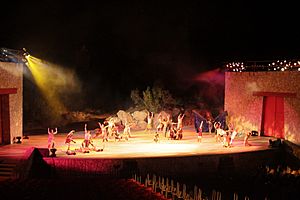
- Viva! El Paso: An outdoor musical show performed in the McKelligon Canyon Amphitheatre. It tells the 400-year story of El Paso's history and culture.
- El Paso Symphony: The oldest performing arts group in El Paso, known for its amazing concerts.
- Ballet: El Paso has a strong ballet tradition, with companies like El Paso Youth Ballet and El Paso City Ballet performing classical and modern shows.
Theaters in El Paso
- Plaza Theatre: A beautiful historic building from 1930. It hosts Broadway shows, concerts, and the annual Plaza Classic Film Festival.
- Abraham Chavez Theatre: A large concert hall shaped like a sombrero. It hosts concerts, Broadway shows, and graduations.
- McKelligon Canyon Amphitheatre: An outdoor theater surrounded by canyon walls, used for concerts and special events.
- El Paso Playhouse: A community theater that puts on plays and theatrical events.
- UTEP Dinner Theatre: Students at UTEP produce and direct musicals here.
Museums to Explore
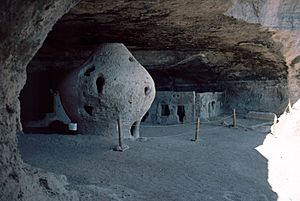
El Paso has many museums where you can learn about history, art, and science:
- Centennial Museum and Chihuahuan Desert Gardens: Located at UTEP, it has Native American pottery and exhibits about the desert.
- El Paso Museum of Archaeology: Shows native plants and ancient shelters, with dioramas about the Southwest's culture and geology.
- El Paso Museum of Art: Features works by artists from the Southwest.
- El Paso Holocaust Museum and Study Center: Teaches about the Holocaust.
- El Paso Museum of History: Explores the history of El Paso.
- National Border Patrol Museum: Shows the history of border patrol.
- Insights El Paso Science Museum: A fun place to learn about science.
Cool Places to Visit
- Ysleta Mission: The oldest church in Texas that has been used continuously.
- Cathedral of Saint Patrick: A beautiful cathedral built in 1916.
- Chamizal National Memorial: A park with art galleries, a theater, and a museum about the U.S.-Mexico border.
- El Paso Zoo: Home to 220 different animal species.
- University of Texas at El Paso: Known for its unique fortress-like architecture, inspired by buildings in the Himalayas.
Sports in El Paso
El Paso is a city that loves sports!
- Sun Bowl: This is the second-oldest college football game in the country, played every year since 1935.
- El Paso Chihuahuas: The city's professional Triple-A baseball team, part of the San Diego Padres family. They play at Southwest University Park.
- El Paso Locomotive FC: A professional soccer team that started in 2019 and also plays at Southwest University Park.
- El Paso Marathon: An annual running event since 2007.
- UTEP Miners: The sports teams from the University of Texas at El Paso, including football and basketball, play in Conference USA.
Parks and Outdoor Fun
El Paso is home to some amazing parks and outdoor areas.
Franklin Mountains State Park
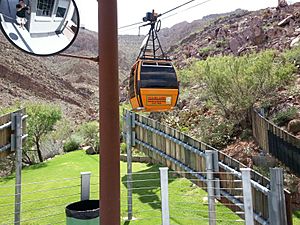
This park is the largest urban park in the nation, located entirely within El Paso. It's great for hiking, mountain biking, and picnics. Scenic Drive offers amazing views of El Paso and Ciudad Juárez. The Wyler Aerial Tramway used to take visitors up to Ranger Peak for incredible views, but it is currently closed.
Hueco Tanks State Historic Site
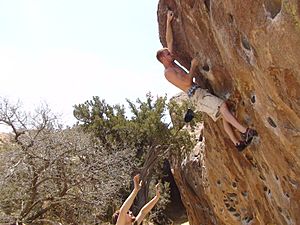
About 32 miles northeast of downtown, this site is famous for its ancient rock paintings (pictographs) and is very important to Native Americans. It's also known worldwide for bouldering (rock climbing without ropes). Climbers from all over the world visit this park!
San Jacinto Plaza
Located downtown, this historic park is famous for its alligator statues. It used to have live alligators until 1974, when they moved to the El Paso Zoo. The plaza is a popular spot for festivals like "Chalk the Block Arts Festival."
Chamizal National Memorial
This park is a cultural center with art galleries, a theater, and a museum about the U.S.-Mexico border.
Gardens and Nature Areas
- Chihuahuan Desert Gardens: Displays over 625 different types of plants from the Chihuahuan Desert.
- El Paso Municipal Rose Garden: Has over 1,900 rosebushes with 500 varieties.
- Feather Lake: A wildlife sanctuary with a wetland that attracts over 200 different bird species.
- Keystone Heritage Park: Features an ancient archaeological site (4,500 years old!), wetlands, and a desert botanical garden.
- Rio Bosque Wetlands: A city park where many animals and birds have returned as the area is restored.
Golf Courses
El Paso has 16 golf courses. Butterfield Trail Golf Club is a top-ranked public golf course in Texas.
Education in El Paso
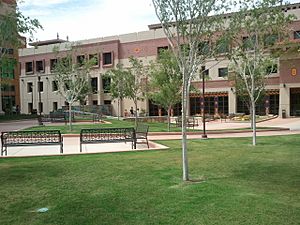
El Paso is a great place for learning!
- University of Texas at El Paso (UTEP): The largest public university in the region. It's known for its engineering program, which produces many Hispanic engineers.
- Texas Tech University Health Sciences Center at El Paso: A major medical school that trains doctors and other healthcare professionals.
- El Paso Community College: Offers many different courses and programs.
- There are also many private schools, including religious schools and Montessori schools.
El Paso is also home to groups that help with job training in new technologies like robotics and AI.
Public Libraries
The El Paso Public Library has 12 branches, a bookmobile, and mobile computer classrooms. They offer many services for the community.
Media and News
You can stay updated on El Paso news through various sources:
- Newspapers: The El Paso Times (English) and El Diario de El Paso (Spanish) are daily newspapers. There are also online newspapers like El Paso Herald-Post and El Paso Matters.
- Radio Stations: Many local radio stations play different types of music and news. You can also hear stations from Las Cruces, New Mexico, and Ciudad Juárez, Mexico.
- Television: El Paso has several TV channels, including KCOS-TV (PBS) and other local news channels.
City Services and Travel
Healthcare
El Paso is a major center for healthcare in West Texas and Southern New Mexico. It has many modern medical centers and hospitals, including:
- University Medical Center: The only top-level trauma center in the region.
- William Beaumont Army Medical Center: A large military hospital.
- El Paso Children's Hospital: A hospital just for kids.
- The city is also home to the Medical Center of the Americas, a big group of medical facilities for research and care.
Transportation
El Paso has several ways to get around:
- El Paso International Airport: The main airport for the region, handling millions of passengers each year.
- Amtrak: The national passenger train system, with service from the historic Union Depot.
- Highways: Major highways like Interstate 10 connect El Paso to other big cities. Transmountain Road (Loop 375) crosses the Franklin Mountains.
- International Bridges: El Paso shares four international bridges and one rail bridge with Ciudad Juárez, Mexico. These bridges are busy crossing points between the two countries.
Public Transportation
- Sun Metro Mass Transit System: Operates buses throughout the city. In 2011, Sun Metro was named one of the best public transit systems in North America for a mid-size city.
- El Paso Streetcar: A modern streetcar system that opened in 2018. It uses restored historic streetcars and runs in two loops from downtown to UTEP.
Water Supply
El Paso gets some of its water from the Kay Bailey Hutchison Desalination Plant. This plant takes salty groundwater and cleans it using a process called reverse osmosis, making it safe to drink. This helps increase El Paso's water supply.
Sister Cities
El Paso has special connections with other cities:
See also
 In Spanish: El Paso (Texas) para niños
In Spanish: El Paso (Texas) para niños


